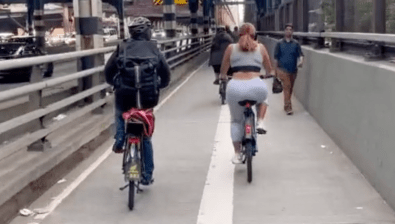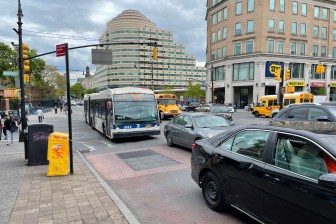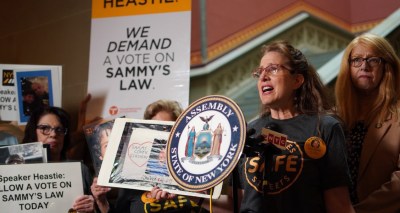Ciclovia: Is NYC Ready?
With a successful Bike Month now behind us and a spectacular Tour de Brooklyn completed, we perhaps have an opportunity to dream bigger for how we can celebrate our bicyclists, our streets and communities in this city.
I was recently in Bogotá for their weekly Ciclovia event and experienced first hand what may be one of the simplest and most powerful ideas for bringing a livable streets movement into reality.

Ciclovia spans over 70 miles of the city every Sunday and holiday, enabling people to explore communities previously perceived as unwelcoming to anyone but cars.
"It is like a gigantic
paved park that is open 7 hours a week, and people of all ages and backgrounds
take over the otherwise car dominated space and have fun." This is how Gil (Guillermo) Peñalosa describes the event that he led to world renowned success.
Ciclovia is no small accomplishment. With great leadership in the city from Gil and others the event has grown to
where now, every Sunday and holiday an average of 1.5 million (up to 2 million) people use more than 70 Miles of
city streets for everything but driving cars.

All modes (except cars) and all ages, sizes, classes share the road.
The event seems as simple and direct a way as possible at
addressing the great class and race divides in Colombia.
When Gil Peñalosa was first Parks
commissioner, in the administration before his brother’s (Enrique), there were eight miles and about 140,000 riders every Sunday; in two years he had increased the distance to 70 miles and 1.5 million people! Gil also led the creation of a managerial
structure, with managers, volunteers, uniforms, marketing, signage, and other activities such
as aerobics, bike day, food vendors, and bike repair stands.
Gil likes to say that "You will see people in
$5,000 bikes and others in $50 bikes, and all having the same fun! Rich and poor,
young and old, men and woman, tall or short… ALL!" The event is also credited with generating everyday
bicycle riders for the extensive network of protected bicycle lanes in the city
(implemented by Enrique’s administration) by quickly getting people
comfortable riding bikes in a city that previously had very few bicyclists.

A lawbreaker is reprimanded, politely, by the ride facilitators. Cyclovia
is the ultimate critical mass ride with 350 city employees helping to make
people feel safe and comfortable.
An average of 1.5 million attending in a city of seven million is a very popular
event. Surveys show that it is not the
same 1.5 m every week, but that at least four million are users at some time of
the year. The surveys showed that the average time that people spent on the
Ciclovia was 4 hours and 15 minutes, where their normal excise routine lasted only 48 minutes.
Gil is sure to point out though that "they go to walk or bike, skate or
do aerobics… AND to watch people, a preferred activity by human beings." Certainly, what struck me more than anything else was just how the opportunity to be outside and around other people seemed to make the thousands of people I saw so happy and friendly.

The "Bike Watch" ride marshals give care to an injured rider.
Gil’s expertise and infectious enthusiasm is being shared around the world as he
works with cities to promote walking, bicycling and placemaking as director of
Walk and Bike for Life in Oakville,
Canada. Among his many efforts, Gil is currently working with leaders in Chicago,
Cleveland, Baltimore, and Vancouver trying to develop programs similar to
Ciclovia at a smaller scale. He also helped set up a successful program
in Guadalajara,
Mexico that is now in its third year; it began with eight miles and when it reached
75,000 participants, it was increased to 14 miles and currently attracts
140,000 every week. Several other cities in South
America, like Quito, Ecuador and Santiago, Chile have also successfully implemented similar programs.
Clearly, it is an idea that can be relatively easily applied in many different
forms in a wide range of urban contexts. As
Gil says, "the infrastructure is there, there are no major needs of
capital investments, no sports complex to build. It is an operational cost and
it takes political will, public sector staff that are doers (looking for solutions to problems and not problems to solutions), and community engagement."

In a city that has been built for children, the children, and most every other public space user,
seem to reflect the respect given to them.
How would we start planning such an idea in NYC? How could it be
phased in, in a politically feasible manner that could test the concept while
drawing people from around the city and getting enough use to make it
work? Could we close Broadway on Sundays? How about Brooklyn’s 5th
Avenue, or Bedford Avenue (closing some streets to cars
in Hassidic neighborhoods on a Saturday might be appropriate)? Where else?





